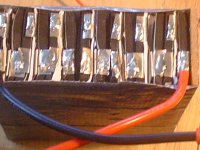For those who are interested. Not exactly scientific but results should be close enough.
I ran all these packs through my powerlab 8 charger from 4.1 volts to 3.7 volts discharging around 4 amps for my 6s packs. Discharge stopped when lowest cell hits 3.7 volts.
I tested each pack at November 2013 and again at November 2014.
The packs were used about 4 to 5 times per week from June through September. The packs also stayed in my bike in my hot garage reaches 90's in the summer.
I didn't use the batteries much during the winter and didn't use the bike for a full 3 months during this time also. Some packs stayed in the garage during the winter some in the basement which is around high 50's F during the winter.
My guess would be around 100-150 cycles for the year.
Batteries are all Turnigy 6s 20C 5000 lipo.
6 packs were brand new at the beginning of the 1 year test.
Because of my very large battery size 2700 watt hours, the packs didn't see high discharge and charge rates on them.
Packs were usually run from 4.1 charged, down to about 3.7 to 3.75.
I mostly always charged right before riding and almost always had my cells discharged and stored around 3.75 volts.
I ran 24 packs but converted down to 21 packs recently and removed 3 packs about a month ago. Those packs are not in the test.
Capacity loss in 1 year.
Average of all 21 packs capacity loss = 6.23%
Average of 6 brand new packs capacity loss = 5.05%
Average of 11 older packs without weak cells = 5.89%
Average of capacity loss of 16 packs without any weak cells = 5.6%
Capacity losses of packs higher than 7% = 9.74%, 8.5%, 8.5%, 8.6%, 9.8%, 10.35%, 7.95%
Most of the packs with higher capacity loss was due to a slightly weak cell that hit 3.7 volts before other cells. Voltage would quickly come back to same as other cells.
My thoughts: I am very surprised that after 1 year my average capacity loss was around 6%. I had the packs in my very hot New York City garage during the summer and felt like I did a lot of riding. The packs were also subjected to lots of harsh off-road riding.
From reading this forum I was under the impression that lipos don't last that long. It seems that at a 6% capacity loss a year, I could be using these lipos easily for 4-5 years.
The newer packs had less capacity loss possibly from the fact that I didn't install these packs until later in the year, they could have seen 20-30% less cycles than the older packs. They do look like they fared slightly better with capacity loss even with the lower cycles on them.
I ran all these packs through my powerlab 8 charger from 4.1 volts to 3.7 volts discharging around 4 amps for my 6s packs. Discharge stopped when lowest cell hits 3.7 volts.
I tested each pack at November 2013 and again at November 2014.
The packs were used about 4 to 5 times per week from June through September. The packs also stayed in my bike in my hot garage reaches 90's in the summer.
I didn't use the batteries much during the winter and didn't use the bike for a full 3 months during this time also. Some packs stayed in the garage during the winter some in the basement which is around high 50's F during the winter.
My guess would be around 100-150 cycles for the year.
Batteries are all Turnigy 6s 20C 5000 lipo.
6 packs were brand new at the beginning of the 1 year test.
Because of my very large battery size 2700 watt hours, the packs didn't see high discharge and charge rates on them.
Packs were usually run from 4.1 charged, down to about 3.7 to 3.75.
I mostly always charged right before riding and almost always had my cells discharged and stored around 3.75 volts.
I ran 24 packs but converted down to 21 packs recently and removed 3 packs about a month ago. Those packs are not in the test.
Capacity loss in 1 year.
Average of all 21 packs capacity loss = 6.23%
Average of 6 brand new packs capacity loss = 5.05%
Average of 11 older packs without weak cells = 5.89%
Average of capacity loss of 16 packs without any weak cells = 5.6%
Capacity losses of packs higher than 7% = 9.74%, 8.5%, 8.5%, 8.6%, 9.8%, 10.35%, 7.95%
Most of the packs with higher capacity loss was due to a slightly weak cell that hit 3.7 volts before other cells. Voltage would quickly come back to same as other cells.
My thoughts: I am very surprised that after 1 year my average capacity loss was around 6%. I had the packs in my very hot New York City garage during the summer and felt like I did a lot of riding. The packs were also subjected to lots of harsh off-road riding.
From reading this forum I was under the impression that lipos don't last that long. It seems that at a 6% capacity loss a year, I could be using these lipos easily for 4-5 years.
The newer packs had less capacity loss possibly from the fact that I didn't install these packs until later in the year, they could have seen 20-30% less cycles than the older packs. They do look like they fared slightly better with capacity loss even with the lower cycles on them.


